Wall-mounted or floor-standing gas boiler - which is better? Arguments for choosing the best equipment
We are faced with a dilemma: wall-mounted or floor-mounted gas boiler - which is better? Believe me, every second buyer of heating equipment turns to consultants with this question. And it’s good if he comes across a competent and qualified specialist. It’s another matter if the person in front of him is an amateur...
Since you do not know which consultants or sellers you will have to deal with, we recommend that you sort out everything in this matter for yourself before going to the store.
We offer a professional answer to the question of which boiler is better for a home or apartment, as well as what exactly. In this comparative review, you will learn how they differ from each other and what these differences affect in the process.
The content of the article:
Wall-mounted and floor-standing boilers: differences
To choose between two models, you need to be aware of their differences, and also understand what they entail in practice. Therefore, we will briefly go through all the parameters.
Efficiency and energy consumption
Modern models of floor-standing boilers have an efficiency of 88-90% (models with the old configuration - about 85%). As for wall-mounted ones, the same figure is higher - 90-94%. Accordingly, energy consumption in boilers with lower efficiency is higher, which means that energy costs are also higher.
But you cannot evaluate the efficiency of a model only by the installation method - its efficiency is also influenced by the principle of operation. In the latter case, a distinction is made between conventional and condensing boilers.
Almost all floor-standing boilers are convection - they are cheaper and demonstrate lower efficiency. Although at the same time, due to their simpler internal structure, their repairs are cheaper, and this is a plus.
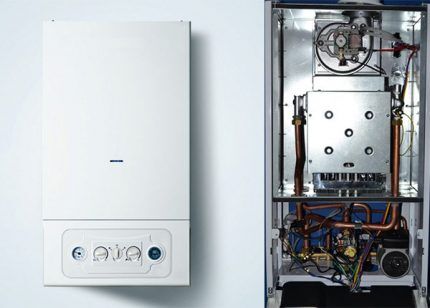
Wall-mounted - can be either convection or condensation. In the latter, the heat generated from heated gases and combustion products is additionally transferred to the coolant. Thus, the heat does not “fly down the chimney”, but is effectively used. The only inconvenience is that it is necessary to equip a condensate drain from the boiler.
Wherein floor models They can also be condensation, but this is a slow-selling product, since their price exceeds 150 thousand rubles.
Heat exchanger material and service life
This criterion is used to determine the reliability of the device.
Specific models traditionally have their own heat exchangers:
- Floor-standing models use reliable and heavy cast iron. It is good because it is not afraid of corrosion, is durable and has a high density and thickness. This allows boilers with a cast iron heat exchanger to operate without interruption for up to 25 years.
- In suspended boilers, it is replaced with light steel or copper. Steel is a cheaper option, but is thin and therefore prone to warping and rusting. Such models will last, if you're lucky, 12-13 years. Copper is more durable and conducts heat better, but is used only in expensive models.
Please note that the statement seems to wall-mounted boilers less reliable due to the complexity of their design, nothing more than a myth.
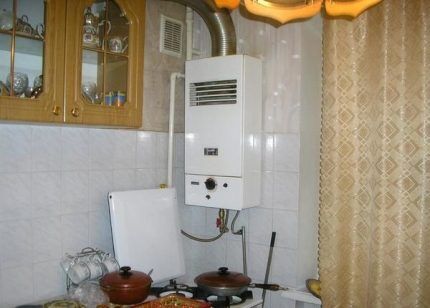
In fact, durability is affected not by the number of parts and structural elements, but by the material of the heat exchanger.
So, it is in floor-standing models that a cast iron heat exchanger is most often installed, which is considered the most durable material. Therefore, their service life differs from wall-mounted boilers in which heat exchangers of lighter materials are mounted.
Design features and dimensions
If you think that the more the better, then you are mistaken. In this case, the functionality of the equipment has nothing to do with the dimensions.
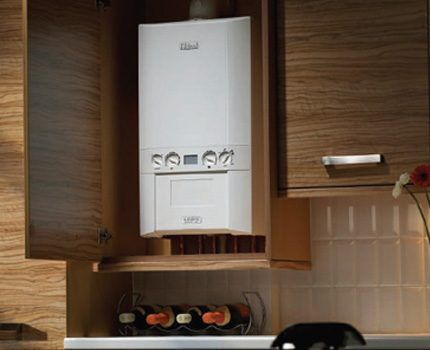
Surprisingly, but true: more complex wall-mounted boilers are smaller in size than more primitive floor-standing boilers. The first ones are entire mini-boiler houses.
In the design of gas single-circuit and double-circuit wall-mounted boilers Depending on the tasks to be solved, the following are used:
- one or two circulation pumps;
- closed expansion tank;
- pressure gauge;
- thermometer;
- air vent;
- safety valve.
The second ones have a simpler design and require separate installation of an expansion tank and a pump, which in some cases can be completely dispensed with.
Dependence on the power grid
If you want it competently choose a gas boiler, you should take into account the specifics of electricity supply in your region. The non-volatile model will work even in the event of a power outage. If there are problems, choose floor-standing models. About half of them are energy independent.
The only drawback is the piezo horn, which must be done manually. However, in a situation with unstable energy supplies, you can turn a blind eye to this minus for the sake of stable operation of the boiler.
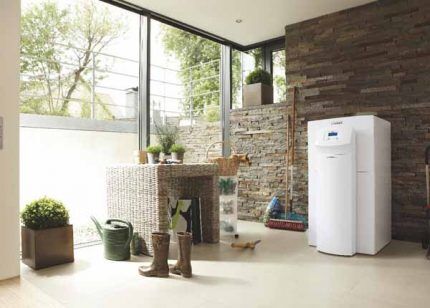
As for wall-mounted boilers, there are no options: they all require connection to the electrical network, and if you want to make the heating system non-volatile, you will have to additionally install a generator or UPS (uninterruptable power source), which of course will result in additional expenses.
Automation and set of functions
The automation of wall-mounted boilers is more advanced, so they are more convenient, safe and easy to use. For example, they are equipped with a frost prevention mode, protection against overheating, pump blocking, lack of traction, and self-diagnosis.
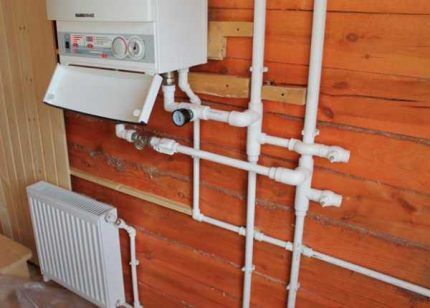
Among the functional capabilities of floor modifications, gas control and overheating prevention should be mentioned. Auto-ignition is less common.
Coolant and its properties
Here, again, the choice will depend on where the heating system will be installed and how often it will be used:
- Floor standing boilers can work with any coolant. Antifreeze is also suitable, so if you need to heat a dacha or a house where you do not live permanently, you should choose floor-mounted configurations with antifreeze as a coolant. This way you won’t have to worry about the system freezing or depressurizing.
- Wall-mounted appliances cannot run on antifreeze. The reason lies in the viscosity and fluidity of the substance, as well as its negative impact on the condition of steel or copper heat exchangers, which are used in mounted models.
If you focus on this criterion and decide whether to choose a floor-standing or wall-mounted model of a gas boiler, which unit is more reasonable to prefer, then floor-standing designs definitely win.
Burner and chimney type
Mounted boilers always (even inexpensive ones) have simulated burners installed, while floor-mounted boilers have one- or two-stage ones.
Let's briefly explain what this means:
- Single stage. Those that can only be in the on or off position, and do not imply intermediate modes.
- Two-stage. They can operate at 50% or 100% power control.
- Modulated. The user can at his own discretion select the operating mode from 20% to 100% power.
The “ideal” mode is considered to be one in which fuel is constantly burned at minimum power. More advanced modulating burners allow you to more accurately set the temperature and use gas more economically.

As for the chimney, in 90% of cases with floor-standing boilers it has to be equipped separately. This is explained by the fact that they are equipped with an atmospheric burner and an open combustion chamber, i.e. the air that is taken from the premises must subsequently be “discharged” outside.
In wall-mounted models, the combustion chamber is closed, so air enters and exits through coaxial chimney. Floor-standing models with a turbine burner also remove gas processing products using a coaxial system.
Installation of models with a two-pipe chimney is simple and less troublesome, but in case of severe frosts (from -15°C and above), condensation will form in it. This can lead to icing and stopping the heating system.

Therefore, according to this criterion, it is impossible to clearly answer which gas boilers are better for you personally - wall-mounted or floor-mounted. As you can see, with a floor-mounted chimney you will have to tinker with the chimney longer, but in the future you can rest assured that its stable operation even in severe frosts.
As for the wall-mounted one, there will be less hassle during the installation process, but more trouble when the thermometer drops below -15°C.
Price difference and assortment
Wall-mounted structures, even despite their more modern and laconic design, as well as a more complex device, are cheaper than floor-mounted ones.
This can be explained by the fact that the market for mounted models is more competitive. There is more demand for them - naturally, manufacturers offer more options and price differences.
Which boiler is best for a home or apartment?
It is difficult to give a universal assessment, since each situation is individual, but basically in practice it happens like this:
- floor structures are purchased for heating the private sector (houses, cottages);
- hanging - for apartments due to their small size and visual appeal.
Although it is important to make a reservation here. In every sense, floor-mounted mini-boiler rooms are definitely more reliable, since they have a more durable heat exchanger, and they are also easy to use even at critically low temperatures outside.
Plus, add energy independence to everything, and then you will understand why many people prefer to install them even in apartments.
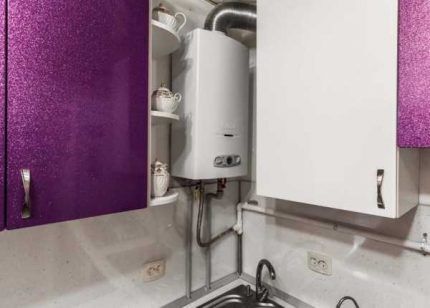
But if you have limited living space and live in a region where severe frosts are very rare, it is more rational to install a wall modification. It will also cost less.
Pros and cons in comparison
Before buying a boiler, carefully study the strengths and weaknesses of both types of equipment. They differ not only in appearance, weight and gas consumption, but also in performance characteristics. The table below will help you learn more about these differences.
The following table presents the advantages and disadvantages of a floor-standing boiler:
| pros | Minuses |
| 1. High productivity due to the large volume of the combustion chamber. | 1. Heavy weight.Especially when it comes to industrial models, although household ones are also not compact. |
| 2. Reliable heat exchangers made of thick-walled steel or cast iron, which guarantee a long service life.
| 2. Classic type of chimney. This means that you will have to punch a hole into the street and connect a pipe to it that is far from aesthetically pleasing.
|
| 3. Non-volatile. They can even heat objects without electricity.
| 3. Impressive dimensions that can take up most of the living space in the room. |
The following table will familiarize you with the strengths and weaknesses of wall-mounted boilers:
| pros | Minuses |
| 1. Cost-effective. Allows you to save up to 10-15% gas compared to the floor-standing version. | 1. Energy dependence. It contains pumps, sensors and automation that operate from the network. |
| 2. Closed combustion chamber. This results in two advantages: compactness, lightness and the ability to be installed almost anywhere. | 2. Sensitivity to voltage changes. Often, at the slightest jump, the controller burns out, and such a breakdown requires expensive repairs.
|
| 3. Multifunctionality. The latest models are equipped with weather-compensating automation, Internet access and can be controlled by a remote control or smartphone. | 3. Installation and configuration of such equipment is a complex and lengthy process. In addition, there really aren’t many competent specialists who can do it correctly. |
We propose to consider the differences between these modifications of gas equipment on real models, which are currently in high demand and are available from most suppliers.
| Proterm Bear 20 KLOM (floor-standing) | Proterm Lynx Condens 25/30 MKV (wall-mounted) | |
| Ignition | Electrical | Electronic |
| Thermal power (natural gas / liquefied gas) (kW) | 11,9-17/11,2-16 | 6,3-26,5 |
| Efficiency (not less) (%) | 90-92/89-91 | 104 |
| Heat exchanger material | Cast iron | Aluminum-silicon alloy |
| Rated voltage/frequency (V/Hz) | 230/50 | 230/50 |
| Dimensions: width / length / height (mm) | 335/600/880 | 700 / 390 / 280 |
| Weight without water (kg) | 90 kg | 32 |
| DHW | No | There is |
Take the choice of equipment type seriously, since in the future replacing, for example, a floor-standing boiler with a wall-mounted one and vice versa will not be cheap. You will have to pay for the production of new project documentation and registration.
Finally, I would like to note the following market trend: wall-mounted boilers are gradually replacing models that are installed on the floor.
This must also be taken into account, since the further you go, the more difficult it may be to find parts for floor-standing boilers, as well as to find craftsmen who can provide qualified assistance in the event of a breakdown.
Conclusions and useful video on the topic
The expert from the video below will talk in detail about what myths exist regarding both types of equipment and what their features are during operation. This information should finally help you make your choice.

Each type of equipment has its own advantages and disadvantages, so it is impossible to single out a clear leader in this comparative review. It all depends on the conditions and at what facility the boiler will be operated.
Share what you were looking for when buying a gas boiler to furnish your own country house or city apartment. It is possible that your recommendations will be useful to site visitors. Please leave comments in the block below, post photos and ask questions.




My respect to the author of the material, with the signs everything is clear and understandable. I myself will take a wall-mounted boiler to a private house. By and large, the only advantage of a floor-standing one is its service life.
Thanks to the author, I helped an amateur get an idea on choosing a gas boiler. But I have a question: I’m waiting for the main gas to be connected, but work has already been done in the house to install radiators and heated floors. The article states that wall-mounted boilers will not be able to heat antifreeze or other non-freezing liquid - which boiler should I buy if my underfloor heating system is already pumped with liquid?
Good afternoon, Alexander. Warm water floors do not require the use of a special coolant if a copper pipe was not used in laying the route. The only thing is that you did not indicate the purpose of the house: for year-round living or “visiting”.
Antifreeze is used exclusively in cases where they want to save money by turning off the heating for some time in the winter. But do not forget that in such conditions, the repairs made will quickly lose their attractiveness due to constant condensation caused by temperature changes.
I can assume that the heated floors were filled with ordinary water to test the tightness of the system before the final screed.
If they are still filled with antifreeze, then simply drain it and run the system several times (preferably under pressure, use a pressure tester for heating systems) to completely get rid of any remaining liquid.
When turning off the boiler in the cold season with ordinary water, you only need to drain the coolant from the system. Savings on gas consumption when using a wall-mounted condensing boiler compensates for this inconvenience.
It seems even informative, but if the author writes that the efficiency of the boiler is 104 percent!!! There is no faith in the rest of his conclusions. Most likely, all his words are complete profanation and fiction!
Sometimes the efficiency is more than 100%. Do not mislead anyone, the author wrote everything correctly!!!!!
Have you lost your mind? Don't talk nonsense Efficiency Efficiency is a characteristic of the efficiency of a mechanism that converts energy. Energy cannot be converted without loss. You cannot get two kilograms of applesauce from a kilogram of apples. You spend 100% of the energy from gas combustion, some goes into the chimney, some is spent on heating the walls of the combustion chamber, as a result, from 100% of your energy, at best 90% goes to the heat exchanger, and if it turns out that from 100% you get 104% energy, this is already a perpetual motion machine.
Consider maintenance costs and the quality of water as a coolant. The scale will have to be washed out annually